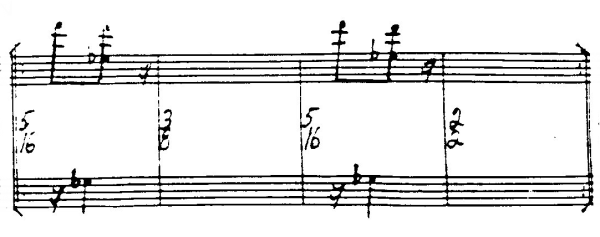The figure above, repeated four times with pauses between, signals the end of the extended sonority of pages 8-10 and the start of something different in the piece. For the next several pages the music is more unsettled, moving forward and backward in time and changing imagery and focus more frequently. I’ll start with a description of the next three pages, which feel like a unit to me.
The first three minutes (pages 11-12) sustain a new image, interlocking eight-notes within a tight chromatic range, with octave displacements:
The pitches here follow the same general course of development as the opening of the piece, starting in the range C-sharp to E-natural, then gradually opening up wider. But the handling of the imagery is quite different; we might say that Feldman’s brushwork is changed. In the opening, he used very taut, extended lines. Here the interlocking figures are floated in silences, some longer, some shorter. This is the notion of “reflection” that I described in an earlier post on Palais de mari: a kind of repetition that gives the music space to penetrate deeper into us. In this case, the figures are presented either singly or strung together into short phrases. They move around different registers in the piano, and a particularly low appearance in the middle of page 12 signals another transition.
What follows is a brief return to the imagery of the opening of the piece: lines of single tones in the limited C-sharp to E-flat range. There’s a feeling of return here, but also a change in focus, from the more spacious to the more single-pointed. This return to the opening lasts for just a minute, but it’s one long, continuous phrase.
Following this is a different kind of interlocking image, similarly chromatic with displacements, but on a different set of pitches:
What really sets this pattern apart from the earlier one is the change in the rhythmic flow. This has less of the quality of reflection and is more continuous, in a way synthesizing the two passages just heard, although not in any obvious or overt way. This runs to the end of page 13 (less than a minute), and then things change more substantially (the subject for a future post).
At this point in the piece, about a third of the way through (at least by page count), I’m struck by the diversity of music we’ve had so far. In Palais de mari I had the feeling of settling down on a specific image and dwelling there for extended periods. In For Bunita Marcus there is much more of a forward drive, an edginess, and, especially in this section and the ones to follow, a searching quality. The opening pages are intense and laser-sharp, and even the very static second section is propelled by the constantly-shifting sixteenth-note rhythmic patterns. And now these next few pages contain a mixture of both, with no sense of settling down at all. I keep wanting to put these passages together into some grand scheme, but it is clear that this isn’t happening yet. Perhaps this is the difference between a longer work like this and a shorter one like Palais de Mari: the energy of this active mind is needed to propel the piece over the longer haul. Or perhaps this is just Feldman’s mind in a more exploratory, less settled state. Whatever it is, I am finding myself quite anxious to turn the page to move forward in the journey.



